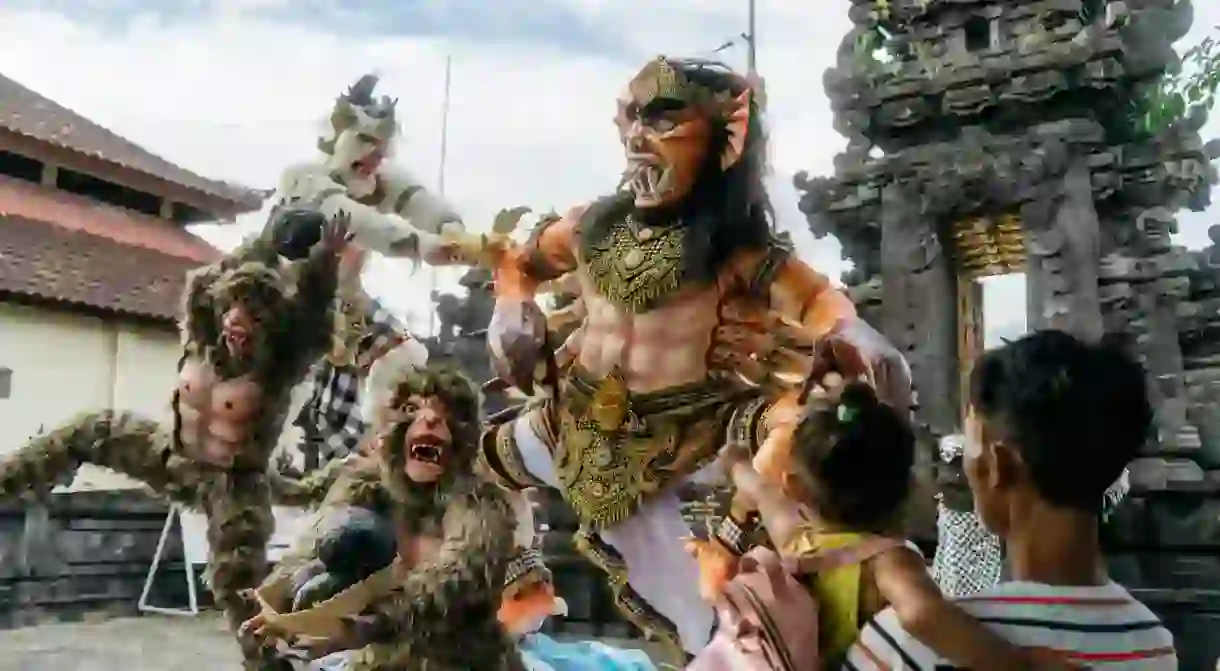New Year's Purification: Burning Demons and Evil Spirits in Bali

Nyepi or the Balinese Day of Silence is, as you can guess by the name, the quietest day of the year in Bali. That’s when Balinese Hindu stay home and refrain from doing anything except praying, fasting, and meditating.
In contrast, the day before holds arguably one of the most lively and vibrant parades in the island, as locals strut around town with monstrous puppets before burning them in a purification ritual and going mute the next day to welcome the quiet and mindful New Year’s unique to Bali.
Flashback to a few weeks before the celebration, youngsters from different banjar (small traditional neighborhood-based unit) come together to work on a very important project: creating ogoh-ogoh, or the papier-mâché statue that will be central to the night before Nyepi’s purification ceremony.

As is portrayed by the scary and demonic appearance, the ogoh-ogoh is meant to represent the evil spirit or whatever negative forces that exist in this world. It can be both external or internal negative energies such as greed, hatred, or envy.

The ogoh-ogoh are mostly made from paper pulp, with bamboo or wood as its pedestal and a skeleton to keep the puppet upright. Nowadays, many even use styrofoam, although the practice has been denounced as it is not as environmentally friendly as using paper.

After this, the figures are painted as realistically as possible, adorned with attributes and ornaments as seen fit, to make them lifelike and also festive.

Nowadays, many even go out of their way to make the best ogoh-ogoh — they make the puppet’s eyes or mouth light up by incorporating electrics and cables.

Although the making of ogoh-ogoh is usually by Balinese Hindu, who make up most of the population on the island, everyone can observe these monstrous puppets and see them in action preceding Bali’s sequence of Saka New Year’s celebration.

Local youths use all kinds of figures to represent the evil spirits or Bhuta Kala. From mythical beasts to the occasional contemporary personification of pop culture villains, they all convey a similar impression: fearful cruelty.

Although some believe in the ancient legend that may have inspired this ogoh-ogoh tradition, the first record of this festival being held is in the 1980s. Back then, the Pengrupukan Parade with ogoh-ogoh was initiated to help bring young people together in one exciting project that also meant something according to the Balinese philosophy and traditions.

Ogoh-ogoh can be up to five meters high and depict epic actions beyond a single figure. They’re built upon a platform that will be the support for when the group carry and parade the statue around town.

It may take up to 30 people to carry a single ogoh-ogoh depending on its weight and size. Fit physical condition and coordination is required as ogoh-ogoh, which actually means ‘to shake’ in local dialect, will be swayed and shaken while paraded, making the statue look even more alive.

Typically, ogoh-ogoh will be paraded around their own neighborhood first, then selected ones will make it to the center of the celebration in Puputan Park, Denpasar, after following certain rules that include busy intersections and streets.

More than just tradition, ogoh-ogoh is the pride of youths. Each locality strives to make the best and showcase them in front of juries and audiences.

The parade
After thorough preparation, ogoh-ogoh are carried and paraded around, often accompanied with traditional gamelan musicians and dancers to create a truly captivating atmosphere.

But more than just a fascinating sight to see, this parade is a mindful tradition that personifies evil spirits and energy, both outside and inside of ourselves — greed, lust, envy, hatred, and every other bad trait you can think of.

Balinese think of this tradition as an exorcism ritual, where you let go of all negativity. Evil forces and qualities will always be in this world, but we can always make mindful efforts to clean and purify our thoughts and deeds in many ways. For Balinese Hindu it’s through symbol-rich vibrant traditions like this.

The night culminates in the ceremonial burning of ogoh-ogoh, which should also be the moment to let go of all the negative in the past and embrace a fresh new start. Tomorrow would be the Nyepi or Day of Silence, which also presents a rare opportunity to meditate and reflect upon the greater things in life.














